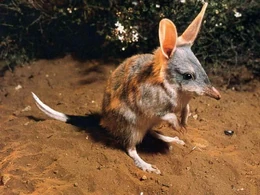
Bandicoots are a group of about 20 species of small to medium-sized, terrestrial marsupial omnivores in the order Peramelemorphia. They are endemic to the Australia–New Guinea region.
Etymology[]
The bandicoot is a member of the order Peramelemorphia, and the word "bandicoot" is often used informally to refer to any peramelemorph, such as the bilby. The term originally referred to the unrelated Indian bandicoot rat. The word is adopted from a Telugu language word "pandi kokku".
Characteristics[]
The embryos of bandicoots, unlike other marsupials, form a placenta-like organ that connects them to the uterine wall. The function of this organ is probably to transfer nutrients from the mother; however the structure is small, compared to those of the Placentalia. Bandicoots may serve as a primary reservoir for Coxiella burnetii. Infection is transmitted among them by ticks. These are then transmitted to domestic animals (cattle, sheep and poultry). The infected domestic animals shed them in urine, faeces, and placental products. It is transmitted to humans causing Q fever by inhalation of aerosols of these materials. Main symptoms may be pneumonia and/or hepatitis.
Classification[]
Classification within the Peramelemorphia used to be simple. There were thought to be two families in the order—the short-legged and mostly herbivorous bandicoots, and the longer-legged, nearly carnivorous bilbies. In recent years, however, it has become clear that the situation is more complex. First, the bandicoots of the New Guinean and far-northern Australian rainforests were deemed distinct from all other bandicoots and were grouped together in the separate family Peroryctidae. More recently, the bandicoot families were reunited in Peramelidae, with the New Guinean species split into four genera in two subfamilies, Peroryctinae and Echymiperinae, while the "true bandicoots" occupy the subfamily Peramelinae. The only exception is the now extinct Pig-footed bandicoot, which has been given its own family, Chaeropodidae.